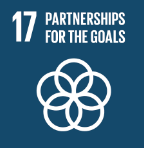SDG17 – Partnerships for the Goals

New Vocabulary
- achieve
- cooperate
- partnership
- face
- grapple
- debt
- limited
Practice the new vocabulary
Partnerships for the Goals Vocabulary Practice (text version)
Match the words to their definitions:
Words:
- cooperate
- debt
- achieve
- face
- limited
- grapple
- partnership
Definitions:
- reach a goal
- work together
- a relationship between 2 people or groups of people
- to confront
- to struggle with
- money you owe
- not having enough, or only having a small amount
Check your answer in footnote[1]
Activity source: Partnerships for the Goals by Virginia McHardy, CC BY-NC 4.0
Partnerships for the Goals
According to the United Nations Department of Economic and Social Affairs (n.d.) Goal 17 Infographic:
Goal 17 is about working together to achieve sustainable development. The 2030 Agenda calls for all countries—rich and poor—to cooperate so that no one is left behind. Governments, businesses, and people must form strong partnerships to solve global problems.
Why is Goal 17 important?
- Some countries face big financial problems, especially after COVID-19. They grapple with high debt and need help to recover.
- Rich countries promised to give financial aid to developing countries, but not all of them have kept their promises.
- Technology is improving, but many poor countries still lack internet access and resources for development.
What progress have we made?
- Some support for sustainable development has grown, but money is still limited.
- The world is more connected through the internet, but not everyone has access.
- Some trade problems between countries make progress difficult.
What do we need to do?
- Share money, technology, and skills to help all countries grow.
- Strong partnerships between governments, businesses, and organizations are needed to speed up progress.
- Countries must check their progress regularly and work together to solve global problems.
Why does this matter to me?
We all share the same world. If countries help each other, we can create a better future for everyone.
Canadian Perspective
Goal 17, Partnerships for the Goals (text version)
Promote peaceful and inclusive societies for sustainable development, provide access to justice for all and build effective, accountable and inclusive institutions at all levels
Canada’s Total Official Support for Sustainable Development (TOSSD)[2]
In 2021, Canada’s TOSSD totalled $8.7 billion. World map showing: Americas: $1,212 million; Europe: $230 million; Africa: $3,838 million; Middle East: $649 million; Oceania: $103 million; Asia: $1,596 million. Funds allocated globally[3] sum to $1,018 million.
In 2020, Canada’s TOSSD peaked to help address the COVID-19 Pandemic.
| Year | Pillar 1: Cross-border flows to TOSSD-eligible countries (Billions of dollars) | Pillar 2: Global and regional expenditures for international public goods (Billions of dollars) | Total |
|---|---|---|---|
| 2019 | 4.809 | 2.32 | 7.1 |
| 2020 | 3.1 | 7.62 | 10.8 |
| 2021 | 3.08 | 5.57 | 8.7 |
| Note: Totals may not add up due to rounding. | |||
Foreign Direct Investment
Between 2015 and 2022, Canadian direct investment abroad increased 91% reaching $1,989.6 billion. Between 2015 and 2022, foreign direct investment in Canada increased 61% reaching $1,263.9 billion.
Community Spotlight: Northern Council for Global Cooperation
Located on the traditional territory of the Kwanlin Dün and Ta’an Kwäch’än Council, in Whitehorse, Yukon, Northern Council for Global Cooperation create pathways for individuals and organizations to be part of the ever-evolving and dynamic global movements for social justice and understand our history to make sense of our present and influence the future.
UNLEASH Innovation Lab: In 2024, 200 youth from around the globe will gather in Whitehorse, Yukon for 7 days to co-create initiatives that address global issues, and equip youth with actionable tools.
Sources: Global Affairs Canada, Statistical Report on International Assistance, 2021-2022. Statistics Canada, Foreign direct investment, 2022. Northern Council for Global Cooperation, 2023.
Source: Goal 17, Partnerships for the Goals In Agenda 2030 Sustainable Development Goals Report, 2022 by Statistics Canada, used under Open License
Discussion Questions
Use the new vocabulary words in these discussion questions. Ask and answer in partners or small groups:
- What do countries need to achieve in order to create a better world for everyone?
- Why is it important for countries to cooperate with each other? Can you think of examples of countries working together?
- What are some benefits of having a partnership between governments, businesses, and communities?
- What problems do developing countries face when trying to improve their economies?
- What does it mean to grapple with debt? How do you think debt affects a country’s ability to grow?
- Why do some countries struggle with debt more than others? How can wealthier countries help?
- Why are resources like money and technology sometimes limited in poorer countries? What can be done to help?
Watch the video:
Watch Goal 17 – Partnerships for the Goals (1 min) on YouTube
Video source: UNStats. (2022, July 7). Goal 17 – Partnerships for the goals [Video]. YouTube. https://www.youtube.com/watch?v=IkqciRZwqHo
Partnerships for the Goals Video quiz (text version)
- True or false? Many countries are having a hard time of recovering after Covid 19 because of the money they owe, especially in the northern parts of Africa.
- Use the numbers to complete the sentence:
Numbers: $117.6 million, $1.58 trillion, 2021, $605 billion, 2020
Sentence: Government aid peaked in [Blank A] with [Blank B], global investing bounced back to [Blank C] from [Blank D] and money sent to families in original countries from migrants totaled [Blank E]. - How much did money for Sustainable Development Goal information go down by in 2020?
- 8%
- 1.8%
- 18%
- True or false? More people used the internet before Covid 19.
- How much did the internet usage percentage rise from 2019 to 2021?
- 54%
- 9%
- 63%
Check your answer in footnote[4]
Activity source: Partnerships for the Goals video quiz by Virginia McHardy, CC BY-NC 4.0
Key Targets for SDG 17
- 17.1 Strengthen domestic resource mobilization, including through international support to developing countries, to improve domestic capacity for tax and other revenue collection.
- 17.2 Developed countries to implement fully their official development assistance commitments, including the commitment by many developed countries to achieve the target of 0.7 per cent of ODA/GNI to developing countries and 0.15 to 0.20 per cent of ODA/GNI to least developed countries ODA providers are encouraged to consider setting a target to provide at least 0.20 per cent of ODA/GNI to least developed countries.
- 17.3 Mobilize additional financial resources for developing countries from multiple sources.
- 17.4 Assist developing countries in attaining long-term debt sustainability through coordinated policies aimed at fostering debt financing, debt relief and debt restructuring, as appropriate, and address the external debt of highly indebted poor countries to reduce debt distress
- 17.5 Adopt and implement investment promotion regimes for least developed countries.
- 17.6 Enhance North-South, South-South and triangular regional and international cooperation on and access to science, technology and innovation and enhance knowledge sharing on mutually agreed terms, including through improved coordination among existing mechanisms, in particular at the United Nations level, and through a global technology facilitation mechanism.
- 17.7 Promote the development, transfer, dissemination and diffusion of environmentally sound technologies to developing countries on favourable terms, including on concessional and preferential terms, as mutually agreed.
- 17.8 Fully operationalize the technology bank and science, technology and innovation capacity-building mechanism for least developed countries by 2017 and enhance the use of enabling technology, in particular information and communications technology.
- 17.9 Enhance international support for implementing effective and targeted capacity-building in developing countries to support national plans to implement all the sustainable development goals, including through North-South, South-South and triangular cooperation.
- 17.10 Promote a universal, rules-based, open, non-discriminatory and equitable multilateral trading system under the World Trade Organization, including through the conclusion of negotiations under its Doha Development Agenda.
- 17.11 Significantly increase the exports of developing countries, in particular with a view to doubling the least developed countries’ share of global exports by 2020.
- 17.12 Realize timely implementation of duty-free and quota-free market access on a lasting basis for all least developed countries, consistent with World Trade Organization decisions, including by ensuring that preferential rules of origin applicable to imports from least developed countries are transparent and simple, and contribute to facilitating market access.
- 17.13 Enhance global macroeconomic stability, including through policy coordination and policy coherence.
- 17.14 Enhance policy coherence for sustainable development.
- 17.15 Respect each country’s policy space and leadership to establish and implement policies for poverty eradication and sustainable development.
- 17.16 Enhance the global partnership for sustainable development, complemented by multi-stakeholder partnerships that mobilize and share knowledge, expertise, technology and financial resources, to support the achievement of the sustainable development goals in all countries, in particular developing countries.
- 17.17 Encourage and promote effective public, public-private and civil society partnerships, building on the experience and resourcing strategies of partnerships.
- 17.18 By 2020, enhance capacity-building support to developing countries, including for least developed countries and small island developing States, to increase significantly the availability of high-quality, timely and reliable data disaggregated by income, gender, age, race, ethnicity, migratory status, disability, geographic location and other characteristics relevant in national contexts.
- 17.19 By 2030, build on existing initiatives to develop measurements of progress on sustainable development that complement gross domestic product, and support statistical capacity-building in developing countries.
Source: United Nations Department of Economic and Social Affairs. (n.d.). Goal 17 [Infographic]. Sustainable Development Goals. https://sdgs.un.org/goals/goal17

Homework/Assignment:
1. Global Partnership Simulation
- Work with a group to “represent” different countries (developed and developing). Each country will have different resources (money, technology, skills). The goal is to negotiate partnerships and find solutions to a global problem (e.g., climate change, education, healthcare).
2. Interview a Community Leader
- Interview a local business owner, teacher, or community leader about how partnerships help improve the community (e.g., local businesses working together, schools partnering with organizations).
- Share your experience and findings with the class.
You can read more about Goal #17 in The Sustainable Development Goals Report 2022 from the UN.:
For instructors, please visit York University’s The SDGs-in-the-Classroom Toolkit for lesson ideas
References
United Nations Department of Economic and Social Affairs. (n.d.). Goal 17 [Infographic]. Sustainable Development Goals. https://sdgs.un.org/goals/goal17
- 1. achieve, 2. cooperate, 3. partnership, 4. face, 5. grapple, 6. debt, 7. limited ↵
- Total Official Support for Sustainable Development (TOSSD) is defined as encompassing all officially supported resource flows to promote sustainable development in developing countries and to support development enablers and address global challenges at regional or global levels. As such, it includes almost all reported Official Development Assistance (ODA). TOSSD also includes private resources mobilized by the official sector (e.g., through public-private partnerships). ↵
- Funds allocated globally refer to funds that are global in nature and cannot be assigned by country or sector, Global Affairs Canada, 2023. ↵
- 1. True. 2. a) 2021, b) $117.6 million c) $1.58 trillion, d) 2020, e) $605 billion. 3. c) 18%. 4. False. 5. c) 9% ↵
reach a goal
work together
a relationship between 2 people or groups of people
to confront
to struggle with
money you owe
not having enough, or only having a small amount

